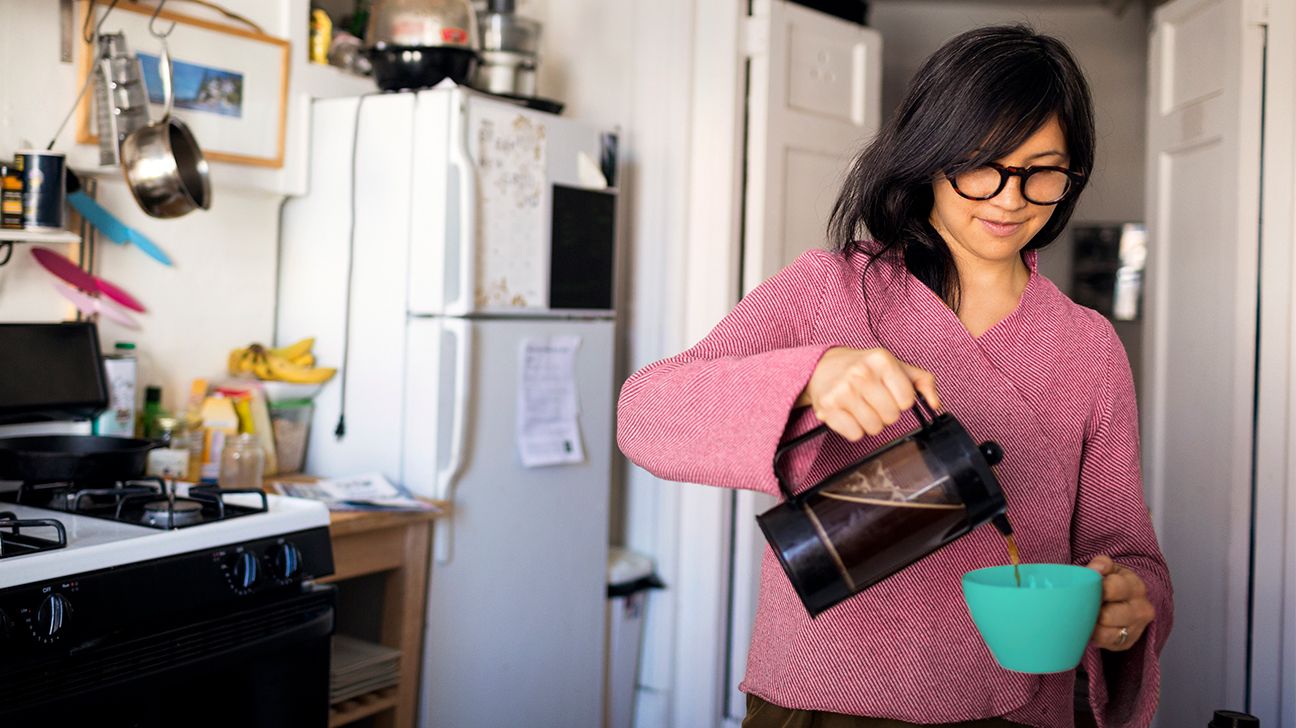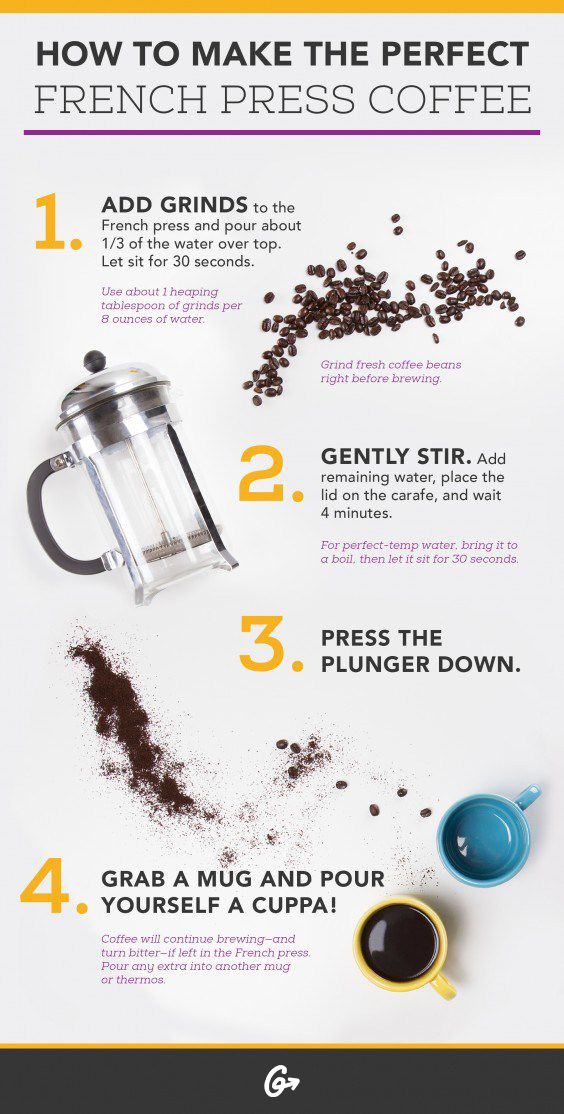Making coffee with a plunger? Sure, at first it might seem a little intimidating and weird. And a French press requires a little more effort than basic drip or a Keurig machine, but it’s way easier than you think.
Trust us: If you can put a pod in a contraption and press a button, you can brew a French press to bring a “sacre bleu!” to the lips of any hardened Parisian.
So you’re waking up 3 minutes earlier make it? It’s so worth it. Immersing the coffee grounds in the hot water during brewing makes French press coffee richer, smoother, and more flavorful than most other methods.
“There’s no paper filter involved, which really allows the oils and flavor in the coffee beans to come through,” says Chad Moore, a Starbucks Global Coffee Engagement team member. We’ve heard they also do coffee.
You’ll never need to pay $5 for a brew again.
Ready for the best java you’ve ever tasted? Follow this simple step-by-step guide from coffee connoisseurs and start sipping. We take the can’t out of decant.
Here’s a full rundown on making the perfect French press coffee. Read on for more details and what to watch out for when getting your hands on those tasty, tasty magic beans.
Coffee is 98 percent water, Moore says, so it makes sense that your water should taste good. But that doesn’t mean hiking out to your nearest natural spring or paying loads to buy fancy water.
“If you want to use tap water, the real rule of thumb is to drink it first. If it tastes OK to you, go ahead and use it,” says Shawn Steiman, author of the forthcoming book The Little Coffee Know-It-All.
Tap leaving a bad taste in your mouth? Grab the filtered or bottled water instead. We love water.
It probably goes without saying, but freshly roasted beans are central to a flavorful cuppa. “You don’t want beans that have been exposed to air for a long time. The beans should look a little oily and smell fresh and aromatic,” Moore says.
There are three ways to get your hands on the best beans.
Flavor sealed containers or bags
Unopened bags or containers stay airtight, so the beans inside will remain fresh until their expiration date. They sometimes stay fresh for years beyond their expiry.
Once opened, though, the beans will start to lose flavor after about a week.
Unsealed containers or bags
If you’re buying beans in a package that isn’t air-sealed (like a paper bag), look for the roast date. Anything roasted longer than a month ago probably won’t be very fresh, according to Moore.
Bulk bins
Bulk coffee beans can be fresh. However, the roast date isn’t always clear, and opened beans have exposure to more air as people open and close the bins.
If you’re not sure whether the bulk coffee you want to buy is fresh, ask your enthusiastic purveyor of beans and buzzy caffeine.
“If you ask a vendor when the coffee was roasted. If they can answer with specific detail, there’s a good chance the coffee is decent,” Steiman says.
We found 25 out-there recipes that use coffee for when you’re feeling that full of beans.
You’ll get the best-flavored French press jet fuel by grinding your beans just before you brew them.
“If you cut into an apple, it starts to oxidize and turn brown. Coffee beans do the same thing, you just can’t see it,” Moore explains.
Don’t go bean-sh*t crazy on the grinding, however. The grounds you’d use in drip coffee are way too small and risk clogging a French press filter. Instead, think big.
This is for coffee, remember. It has to be right, or your day starts on the wrong foot. How much should we grind them, though?
“You want pieces the size of small breadcrumbs or a little smaller than Kosher salt,” Steiman says.
That’s us told.
The strength of the brew comes down to personal taste. This is where the coffee-to-water ratio comes into powerful effect.
Coffee industry consultant Andrew Hetzel leads training courses for the Coffee Quality Institute suggests that 18 to 20 grams of coffee (or a heaping tablespoon) per 8 ounces of water is a starting point.
Want to feel more like you’re decanting a gas pump into your mouth? Moore recommends using 2 tablespoons of coffee per 6 ounces of water.
“If it’s a little too strong, you can always add more hot water to your cup,” he adds. This part is on you. Just be precise with your experimentation.
Measuring pissing you off? Here are 27 baking hacks.
Ouch! Pain and bitterness are never ideal, but overheated water can make coffee bitter, while water that isn’t hot enough means you miss out on flavor. Plus, boiling water is painful, and tepid coffee is yucky. So there’s that.
Aim for a temperature of around 200°F (93°C). But don’t bother breaking out a thermometer — it doesn’t have to be rocket science.
“Bring the water to a boil and let it sit for 30 seconds,” Steiman says. (We did tell you this was easy.)
Place the coffee grounds at the bottom of your French press, and pour about one-third of the water over them.
Hetzel suggests letting the mixture sit for about 30 seconds, then giving it a gentle stir. This makes sure the water fully saturates all the grounds to maximize flavor.
Add the rest of the water, and place the lid on your carafe with the plunger pulled up all the way.
Again, this part is a balancing act. If you don’t brew for long enough, your coffee will taste thin and sour. Too long, and it’ll end up bitter or astringent. You’re in quite the Goldilocks predicament here.
For the best flavor, Hetzel and Moore recommend letting your coffee brew for 4 minutes. If you like your coffee stronger, you can let it go for as long as 6 minutes, Steiman says.
When your timer buzzes, gently but firmly press the plunger all the way down. “Too much pressure can cause the hot coffee to spray out of the carafe and onto you,” Hetzel says. Yowch!
If you’re a drip person, you’re probably used to brewing a big pot of coffee, pouring some into your mug, and letting the rest sit around all morning.
But anything that’s left in a French press will keep brewing since the grounds and the water are still mingling in the carafe. After a few minutes, it’ll turn bitter.
“If you have any leftovers, pour them into another mug or thermos. Or brew less next time,” Steiman says.
A little bit of measuring, accurate timing, and the correct prep can turn a cuppa Joe from Pesci to Mangianello in no time at all.
Very few things match a good coffee as the day breaks.
Now, onto the next question… do you add cream? Phew. So much to consider. Good thing there’s a cup of brown joy in front of you to assist.


